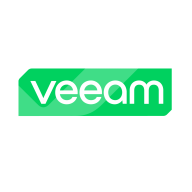

Azure Monitor and Veeam Data Platform both compete in the cloud services monitoring and data backup categories. Veeam seems to have an edge due to its comprehensive backup and recovery capabilities.
Features: Azure Monitor integrates seamlessly with the Microsoft ecosystem, providing dynamic alerting and application monitoring. It offers diagnostic settings, flexible customization, and centralized monitoring for cloud resources. Veeam Data Platform is known for robust backup capabilities, instant recovery, and support for virtualization environments. It includes features like replication, granular restore, and seamless integration with VM environments.
Room for Improvement: Azure Monitor could benefit from better third-party tool integration and broader support beyond Microsoft environments. Additionally, its pricing structure based on data ingestion can hinder budgeting. Veeam Data Platform should enhance integration with diverse storage solutions, expand application support, and simplify user experience for better accessibility.
Ease of Deployment and Customer Service: Azure Monitor offers an easy setup, particularly for Microsoft Azure users, though technical support response times need improvement. Veeam Data Platform has a steeper learning curve due to resource requirements, though its customer service receives mixed reviews, suggesting potential for more seamless support.
Pricing and ROI: Azure Monitor follows a flexible, pay-as-you-go model which can be economical for smaller applications but potentially costly with increased data ingestion. It provides ROI through built-in features. Veeam Data Platform's pricing is higher yet justified by its comprehensive suite and strong data protection, offering significant ROI, especially in complex environments.
Azure Monitor helps prevent impacts on their system.
However, the second-line support is good.
Users end up getting no resolution from their team because they're outsourced vendors, and they don't have deeper expertise over any of the products they are referring to.
I would rate the support for Azure Monitor as a seven.
Most cases are handled perfectly.
I would rate their technical support a 10 out of 10.
The escalation from first, second to third tier is sometimes very long-lasting, but the resolve rate is quite high.
Azure Monitor is very scalable; there are no issues with scalability for different kinds of businesses.
It involves acquiring additional licenses as needed.
In order to scale Veeam Data Platform, we have to pay a lot more money.
Azure Monitor is working fine, yet I face a costing issue as if there are a lot of logs collected in the workspace or in the center, it becomes very costly.
There are no issues with stability in Veeam Data Platform.
If Azure Monitor can independently add one gigabyte, two gigabytes, or five gigabytes at least to log storage, I can fix the logs without syncing with Log Analytics Workspace and Sentinel.
The cost skyrockets once you start using it, and there are complaints that the actual cost of the Kubernetes cluster was less than the cost they were incurring for Azure Monitor.
The challenges with Azure Monitor are that it's initially complex to set up because you need multiple components.
The improvement we would like to see is the option to scale Veeam Data up in smaller sections rather than large sections, which requires paying much more.
Reducing it by 20% would make it more accessible to a broader range of customers.
OpenStack is something Veeam Data Platform doesn't support, and they haven't indicated that they will support it in the future.
When I export logs into the application, workspace, log analytic workspace, and into Sentinel to read reports, I need to add storage, which increases the cost.
I don't consider the price expensive given its importance.
A reduction of 20% in the current cost would make the solution more attractive to clients.
Veeam Data Platform is more expensive than OpenStack because we pay for it in US dollars, while we pay for OpenStack in Egyptian pounds.
The alerting features definitely help in reducing operational downtime for my customers by allowing us to get notifications in advance and take active actions.
Resource monitoring is essential.
The ease of access in Azure is significant because it's native to the platform and easy to integrate.
The platform is user-friendly, comprehensive, and compatible with numerous market solutions, including virtualization and bare metal servers.
The most important aspect of this platform is data security with immutable data in the storage.
Veeam Data Platform is valuable for its stability and the ability to easily contact support for assistance.
| Product | Market Share (%) |
|---|---|
| Azure Monitor | 4.7% |
| Veeam Data Platform | 0.9% |
| Other | 94.4% |


| Company Size | Count |
|---|---|
| Small Business | 23 |
| Midsize Enterprise | 6 |
| Large Enterprise | 29 |
| Company Size | Count |
|---|---|
| Small Business | 216 |
| Midsize Enterprise | 99 |
| Large Enterprise | 138 |
Azure Monitor is a comprehensive monitoring solution offered by Microsoft Azure. It provides a centralized platform for monitoring the performance and health of various Azure resources, applications, and infrastructure.
With Azure Monitor, users can gain insights into the availability, performance, and usage of their applications and infrastructure. The key features of Azure Monitor include metrics, logs, alerts, and dashboards. Metrics allow users to collect and analyze performance data from various Azure resources, such as virtual machines, databases, and storage accounts.
Logs enable users to collect and analyze log data from different sources, including Azure resources, applications, and operating systems. Azure Monitor also provides a robust alerting mechanism that allows users to set up alerts based on specific conditions or thresholds. These alerts can be configured to notify users via email, SMS, or other notification channels. Additionally, Azure Monitor offers customizable dashboards that allow users to visualize and analyze their monitoring data in a personalized and intuitive manner.
Azure Monitor integrates seamlessly with other Azure services, such as Azure Automation and Azure Logic Apps, enabling users to automate actions based on monitoring data. It also supports integration with third-party monitoring tools and services, providing flexibility and extensibility.
Overall, Azure Monitor is a powerful and versatile monitoring solution that helps users gain deep insights into the performance and health of their Azure resources and applications. It offers a wide range of features and integrations, making it a comprehensive solution for monitoring and managing Azure environments.
Veeam Data Platform is designed for modern data management, providing secure backups, intelligent data insights, and resilience. It ensures data is protected, recoverable, and manageable across complex environments, supporting business continuity effectively.
Veeam Data Platform stands out with its robust capabilities in data protection, orchestrated recovery, and efficient management. It offers a simple interface while ensuring data security and availability, which is critical for businesses. The platform's compatibility with virtual machines, databases, and applications across VMware, Hyper-V, and cloud environments makes it a versatile choice for backup and disaster recovery strategies. Users gain confidence from its performance, from secure backups to facilitating effective infrastructure monitoring.
What are the key features of Veeam Data Platform?Veeam Data Platform is widely implemented by industries needing robust disaster recovery plans and data management solutions. It is particularly valuable in environments utilizing hybrid cloud solutions, protecting mission-critical workloads, and ensuring business continuity. Businesses leverage its capabilities to safeguard data integrity and facilitate long-term retention through efficient infrastructure management.
We monitor all Cloud Monitoring Software reviews to prevent fraudulent reviews and keep review quality high. We do not post reviews by company employees or direct competitors. We validate each review for authenticity via cross-reference with LinkedIn, and personal follow-up with the reviewer when necessary.